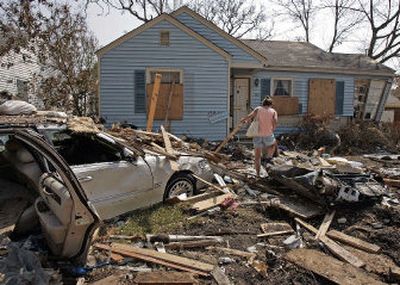Major Adjustments

BAY ST. LOUIS, Miss. — Dian Carpenter arrives at James and Lynn Lewallen’s 1930s frame house in a once-tree-lined neighborhood here. She finds James Lewallen wearing a dust mask and hauling garbage sacks bursting with putrid food. Siding, asphalt shingles and pecans litter the yard, as do massive trees, roots splayed in the air, the wreckage of Hurricane Katrina. “Don’t go in the house,” Lynn Lewallen says apologetically, as if to a neighbor stopping to chat. “It’s bad.”
But Carpenter’s job is to go in the house, with a visit that could prove anything but cordial. She is an adjuster for State Farm Insurance Cos., the biggest home and auto insurer along the Gulf Coast and the nation. She is part of an army that slowly is fanning into the hardest-hit areas to detail the damage to hundreds of thousands of homes in Louisiana, Mississippi and Alabama.
Over the coming months she and her counterparts will determine how much money the storm’s victims receive from the private sector. All told, private insurers are expected to shell out as much as $60 billion, a price tag that would make Katrina nearly three times as expensive as the previous worst storm, Andrew in 1992 in southern Florida.
Claims adjusting is a job defined by tensions. Homeowners want the most generous possible settlement; insurers say they can’t pay any more than required. In the wake of Katrina, those pressures have only grown. Government officials, including Mississippi’s insurance commissioner, have called on insurers to give policyholders the benefit of the doubt, particularly given widespread flood damage that, many fear, was underinsured, if insured at all. Standard homeowners’ policies exclude costs from flooding, a policy provision that leaves payment of billions of dollars of damage in question.
Already, Carpenter has told at least one Gulf Coast family that their federal flood policy isn’t enough to cover the full damage to their home from Katrina’s storm surge.
“Having to tell them (that) this is as much as I can pay — it was heart-wrenching to watch them break down,” she says. “You can’t say. ‘I know how you feel.’ … All you can do is say, ‘I’m sorry.’ ” She steers underinsured policyholders to federal-disaster and Red Cross aid.
Throughout the Gulf Coast, State Farm and other major insurers have established beachheads in strip-mall parking lots. Typically, these are tents with satellite links, where they collect basic damage reports from customers still without electricity and phone service. By Carpenter’s Friday afternoon stop at the Lewallens, State Farm had received more than 213,000 home and 61,000 auto claims from Louisiana, Mississippi, Alabama and Florida. (Through Sunday, home claims had risen to more than 223,000 and auto claims to more than 64,000.)
The Lewallens are just one of 75 Hurricane Katrina claims Carpenter currently is assigned, in addition to the local State Farm agent’s damaged storefront. She figures 80 percent of these rank as “severity 1,” meaning that “the house is either gone or it’s uninhabitable,” she says. “I know I have claims that are just slabs.”
A few days after Katrina hit, Carpenter drove 1,300 miles from her home in Monument, Colo., to Birmingham, Ala., where she joined other State Farm adjusters for a rundown of matters including the federal flood program.
A 26-year State Farm veteran, she has worked for its catastrophe team since 1999. Between disasters, she works “light duty,” teaching other adjusters or taking classes in such topics as differentiating damage to roofs from wind and tree limbs.
Now Katrina will consume 12-hour days, with a weekend off once a month. Last year, Carpenter spent 200 days working Florida’s four hurricanes, seeing her husband rarely. “With a catastrophe of this magnitude,” she says, “I don’t see an end in sight.”
Katrina’s damage “is more gut-wrenching” than other disasters, including the Northridge, Calif., earthquake in 1994, she says, because it is so widespread and massive. She has seen beachfront Mississippi houses overturned by huge waves onto their roofs or washed out to sea.
Her visit to the Lewallens illustrates the laborious nature of the job. Arriving about 1 p.m., she circles the house, snapping pictures with a digital camera and quickly reassuring the homeowners. “I’ll give you some money before I leave,” she says.
Katrina tore away most of the home’s aluminum siding and roofing material. “I think the door actually blew open, because stuff has blown all over the place,” Lewallen says, following the adjuster into her house.
Dim light filters through the few windows James Lewallen, a technician who turned 50 that morning, hadn’t covered with plywood before the storm; furniture and clothes smell of mildew and mold.
Carpenter, a clipboard in hand, peers at a bedroom ceiling. A whole section of drywall is missing, wet insulation pushing through joists. “You can see daylight there,” Lynn Lewallen says, pointing to the ceiling.
Carpenter tells the couple to photograph possessions that can’t be salvaged; their policy will pay for replacements. State Farm won’t pay to remove trees unless they damaged the house, she adds. It will pay storage expenses, apartment rent and certain other costs as their house is fixed.
The Lewallens are lucky: Floodwaters stopped a few blocks short of their house. It also makes things easier for Carpenter. She isn’t faced with the tough call over whether damage was caused by wind-driven rain or flooding, the peril that will bring others heartbreak.
By late afternoon, the Lewallens and Carpenter sit on dinette chairs in the driveway. The adjuster explains that she will work up repair estimates and return to inspect the interior once they sort through possessions and possibly recruit a contractor. Then she’ll send a check for repair costs, made out to them and their mortgage company.
She writes a check for tree-removal and living expenses. “Keep receipts,” she admonishes.
As she leaves, she hugs Lynn Lewallen, knowing some assignments ahead will end on a harsher note.